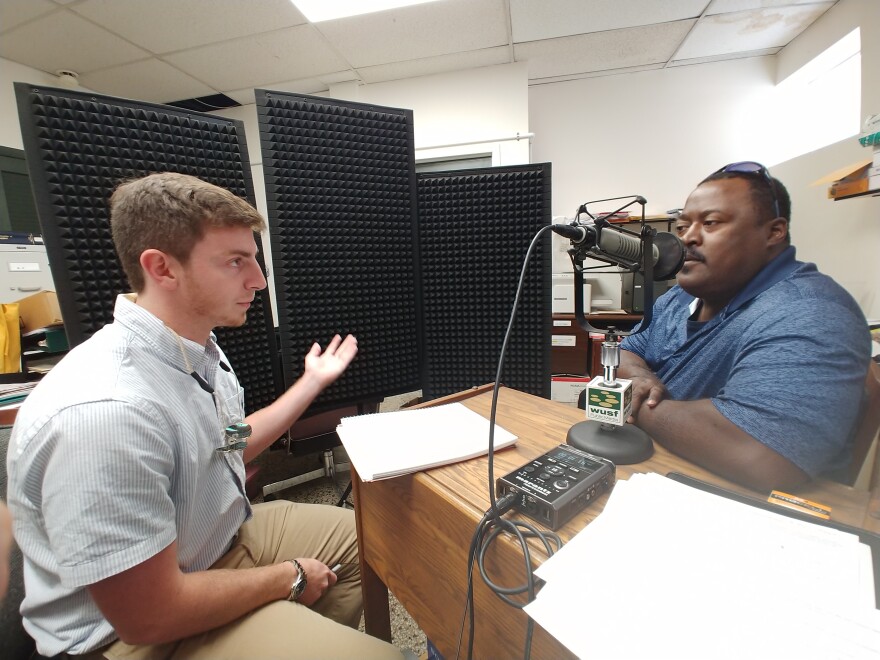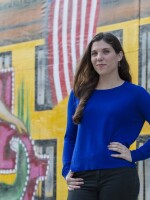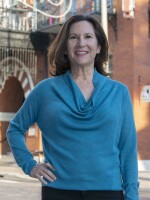In 2017, our series, "Telling Tampa Bay Stories," took us to Tampa's Progress Village. In 2018, the focus turned to Plant City -- a Hillsborough County community where agriculture and development, history and progress all meet.
Since 2016, WUSF has teamed with University of South Florida student journalists to highlight communities in the area and the people who call them home.
The first of a two-part series airs on this week's Florida Matters (this series originally aired in November and December 2018). You can meet some of the people the students interviewed here.
Part 2, which highlights some of the places and events that make Plant City special, will air Feb. 12.
First, here's a video overview of Plant City and the project, produced by USF student journalist Yara Zayas.
Meet Our Storytellers
Judi Whitson
Judi Whitson, executive director of the Hillsborough County Farm Bureau, has been working in Plant City for 27 years. Agriculture has played an important part in Plant City since it was incorporated in 1885 – and not just the strawberries it’s famous for.
“The farmers are the same – they’re farming the same ground that their fathers and their grandfathers farmed before them, so that part of Plant City hasn’t changed a whole lot,” said Whitson.
But a lot has changed, particularly in the last 20 years, due to greening – a disease that kills citrus trees.

“When you see roots on all the trees up, it was just heart-breaking, because you knew that was another field that was gone, that was another grove that wasn’t going to be producing oranges for us,” she said.
Much of the damaged citrus groves have been replaced by new crops: not just strawberries, but peaches, olives, avocados and blueberries.
But in many cases, agriculture has given way to development, which concerns Whitson.
“Every time you see a housing development go up, that was farmland,” she said. “It’s a disheartening thing for me, every time I see a new subdivision go up, it’s like, “Ugh, we lost another one!’”
Whitson was interviewed by Stephanie Colombini and USF student journalist Natalie Eiland.
Cerenio Cervantes-Flores
Whitson said a lot of the farming in Plant City is now being done by migrant labor, like the family of Cerenio Cervantes-Flores.
The 25-year-old’s parents first came to Plant City in 2002, rotating between summers in Ohio and winters in Florida.
“Here, there’s a lot of labor work, there’s a lot of strawberries that need to be picked, a lot of tomatoes that need to be picked, things other people wouldn’t do, so they fill that gap,” said Cervantes-Flores.
“It’s very physically demanding work – you’re out there in the sun, sometimes you work when it’s cold, when it’s hot, when it’s raining,” he said. “You have to be out there, otherwise you could lose your job and you don't want to do that, especially when you have a family to support.”

In their case, Cervantes-Flores’ parents have six children they’re raising. Their example is pushing Cerenio forward, as the recent biology graduate at the University of South Florida prepares to go to medical school.
“That’s one of the motivations that I use to keep studying, go to school, hopefully get a good-paying job in the future and hopefully help them the way they’ve helped me,” he said.
“My family values education a lot,” added Cervantes-Flores. “'Cause I know a lot of people in my situation, somebody who’s undocumented, somebody who lives in the migrant community, someone like me shouldn’t have a bachelor’s degree, but I do.”
“And it’s because of the lessons that they’ve taught me: hard work, dedication, education first. And I’m grateful that they have been supportive every step of the way.”
Cervantes-Flores was interviewed by USF student journalist Chaveli Guzman.
Alvin Futch
Alvin Futch, 87, was born into a farming family – a business he still continues today.
“Grandpa Cone built that home in 1918 and it was a good sized farm,” said Futch. “He grew a lot of Irish potatoes and had cattle and so forth.”

Futch and his siblings grew up on that farm with a variety of chores.
“My brother milked the cows, my job was to feed the horses and my younger brother would feed the hogs and pump water for all the livestock every afternoon and every morning before we went to school,” he said.
That began a lifetime in agriculture.
“The ranch where we are now, my dad and mother put together 1,000 acres over there and we farmed 100 acres of it, growing feed crops for the cattle and growing corn for the horses,” said Futch.
“I still have 65 acres of strawberries and a hundred head of cattle, so that’s what I'm still doing at 87 years-old.”
And Futch said that's not going to change anytime soon.
“I get offers all the time wanting to buy part of the land and develop it and this kind of stuff and we don't do that. We don't need it. We're happy. Home is home, it always is.”
Futch was interviewed by Mark Schreiner and USF student journalist Molly Urnek.
Ed Verner
Ed Verner started in agriculture, but has now moved into property development – including the renovation of Plant City’s downtown. Both jobs run in his family: his grandfather came to Plant City in 1919 as a 19-year-old and became involved in a number of businesses in town, including farming interests, real estate and car dealerships.
“I became a truck driver,” said Verner. “I was actually hauling the fruit to the nearby plants. We were in citrus probably until the late '90s when we began to get out. There was a severe freeze in 1989. Christmas Day, actually. A Christmas present from God.”
As bad as the freeze was, the North American Free Trade Agreement (NAFTA) made things even worse.
“It decimated citrus profits in this area by about 24 cents a pound solid, which back then, that represented about a 30 percent cut in what local growers were getting for their orange juice product,” he said.
That pushed a lot of farmers out of the business.

“You could make a lot of money developing groves into rooftops,” said Verner. “I liked citrus. It was a product that has a good product every single year, and it's an annual flow. And it employed a huge number of people. It was a giant industry in the Plant City area, but once you develop for rooftops, you can make a lot of money once and then you're done.”
While Verner was born and raised in Lakeland, he helped take over the family businesses in Plant City, with a special interest in downtown.
“People frequently say, ‘Oh, I wish Plant City's downtown could be revitalized.’ But I remember in 1995 when I became involved in it more directly, it was dead,” he said. “We had 30 percent occupancy and we were offering 80 percent discounts, and we couldn't find tenants. Now we have almost 100 percent occupancy and we're only offering about 15 percent discounts.”
Verner believes that’s made Plant City’s downtown a place to be – even while some say it can still get better.
“I would argue now Plant City's downtown is fully revitalized. It’s just now, what else does it add?” he said. “I still admire the people who wish it could do more and they get frustrated that we don't have a beer garden or we don't have a tattoo parlor or we don't have a nightlife.”
“We're still shy on the residential component in our downtown,” said Verner. “The thing we’re lacking was the third, fourth and fifth floors of the downtown buildings. But Plant City was only built three stories high. And there's some conjecture about how that came to be. Some people say it was because you couldn't have a building taller than the Baptist church steeple.”
“It's a chicken and the egg thing now,” he said. “If you want to have high-quality residential in a downtown, you have to have something to do after 5 p.m. But if you want to have a beer pub or if you want to have a bakery or if you want to have a doughnut shop or even a place where you can buy a AA battery for your remote control, if you want to have that in downtown, then you have to have the residences.”
“I don't really care whether somebody brings the egg or the chicken to town but somebody is going to have to bring either an egg or a chicken – and then we'll have it.”
Verner was interviewed by Mark Schreiner and USF student journalist Alexa Ignacio.
William Thomas, Jr.
William Thomas, Jr. is president of the Improvement League of Plant City. One of the non-profit’s signature projects is the Bing Rooming House, an African-American Museum that served as a hotel for blacks during the era of segregation.
“It was owned by Mrs. Janie L. Bing and her husband E.L. Bing Sr. It was one of the more successful, notable businesses during that time, anchoring a black historic district in that area,” said Thomas. “One of the grandchildren deeded the house to the organization and we took on that project to restore it into a museum.”
The museum focuses on some of the more famous names who stayed there: musicians and athletes who weren’t allowed to spend the night in other hotels because they were black.
“We always try to confirm, obviously, who stayed there. Muddy Waters was an often frequent guest there, he was notable in the jazz arena, a musician. We do have those who say James Brown stayed there, there are a lot of oral history accounts of that,” said Thomas.
“Negro League baseball players were major tenants of that location. We confirmed that through Major League Baseball a number of years ago when their historians came into town and affirmed that,” he said. “Satchel Paige stayed there when he was playing the Homestead Grays and travelling between the Florida circuit.”

Other people stayed in the Bing House as well.
“Ironically a number of school teachers (stayed there) we found out, being that it was a rooming house. During the era of segregation, transportation was limited,” said Thomas. “There was a Marshall High School in Plant City at that time. There were a number of teachers that were recruited from Tampa that would come and stay at the rooming house and teach at the school and then commute back home on the weekends.”
Thomas said he saw some lingering signs of racial division in Plant City when he came home from the military in the 1990’s, but he feels things have changed.
“I remember when (The Improvement League of Plant City) first took on the (Bing House) project and presented it to the city, there was a poll that was conducted through the Plant City Courier and that poll reached out citywide,” he said. “There was an 80 percent turnout that (the community) felt the Bing House was not a good idea.
“Now moving forward 16 or 17 years later, the Bing House is well-attended by people from various diversities throughout the city of Plant City. So it just goes to show you that the mentality of the culture has indeed changed.”
Thomas was interviewed by Mark Schreiner and USF student journalist Sam Newlon.
Janell Green Johnson
Retired schoolteacher Janell Green Johnson is the granddaughter of the original owners of the Bing Rooming House.
“It was a place all of the family would come together at holidays and tell stories and play,” she said. “There was always plenty of love and stories told and so the restoration of the House means that we can kind of keep those memories. But it's also a place to house the history of African Americans here in Plant City and their accomplishments.”
Johnson said, even as a child, she was aware of segregation in Plant City.
“There were places in downtown Plant City that you knew that you didn't venture into,” she said. “I remember the ‘colored only’ signs. You had the water fountain that you could drink out of. You couldn't go up to the counter to order a sandwich or anything, but my parents taught us to not even go near the counter.”

But even after schools in Plant City were integrated, Johnson said things didn’t totally change.
“I can remember one day walking downtown and seeing a classmate who walked across the street so that they would not have to interact with me,” she said.
“I was blessed in that I never saw anything horrific happen. I heard of things but never saw anything,” said Johnson. “Like I said before, I knew there were restaurants."
“There's a restaurant right here, right now that I have never stepped foot in, because I grew up knowing during the time when I was young that if you wanted something you had to go to the back door,” she said. “I was not going to the back door. No one in my family was going to the back door. I've never stepped foot in there.
“My husband was not raised here. He's been there and my son has been there. But I've explained to both of them why I don't go there. And that's just the way it is,” she said.
Johnson thinks there’s been some changes for the better. She points to her relationship with a white woman who she’s been friends with since that woman first approached her while Johnson sat alone in the cafeteria on her first day at Plant City High School.
“We don't see each other all the time, but we know. I remember that and that meant a lot to me,” she said. “When I was teaching at Cork Elementary, her daughter was a student and so we reconnected. And her daughter and my son were in classes together and so it was like full circle.”
Johnson was interviewed by Stephanie Colombini and USF student journalist Jeremy Wade.
About The Project
Telling Tampa Bay Stories: Plant City is a collaboration with journalism students at the University of South Florida’s Zimmerman School of Advertising and Mass Communications. Together, we hosted an interview session in Plant City at the Plant City Photo Archives and History Center to collect the stories featured in this two-part series.
Special thanks to all those who shared their stories with us both on and off the air, and thanks to the employees at the Plant City Photo Archives and History Center for helping facilitate our interview sessions.
Much thanks also to USF journalism instructor Jeanette Abrahamsen and Plant City Photo Archives Executive Director Gilbert Gott for the important roles they played in this series.










